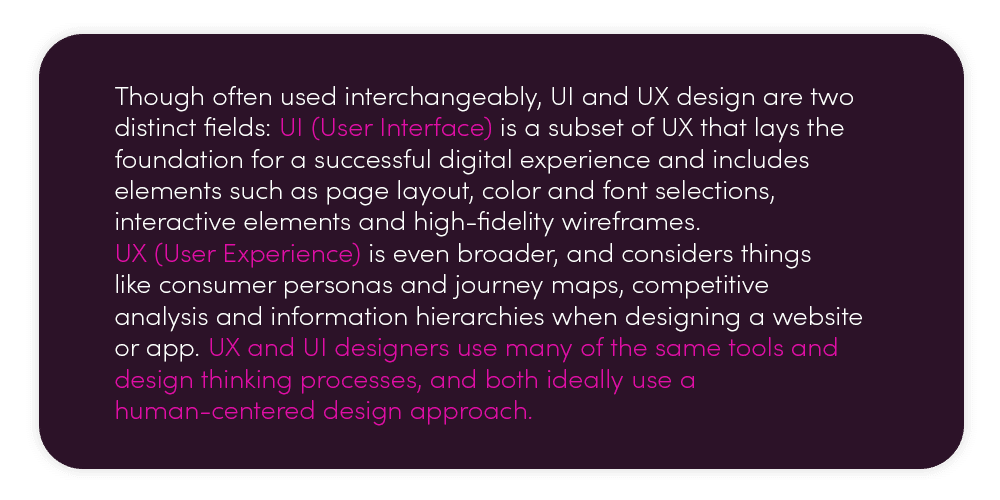It was barely 30 years ago that the internet was made public, and yet websites, social media platforms and digital apps have already become so ubiquitous that most of us hardly think about what they look like and how they work—we simply interact with them.
Of course, for people like Jake Zastrow, Associate Director of UX at (human)x and Sam Noel, UX Designer at (human)x, things like digital design and functionality are constantly top of mind. While the past three decades have seen the steady evolution of digital transformation trends, such as mobile-first and responsible web design, accessible and user-centered design, and data-driven UX decisions, the rise of AI is rapidly changing both how users interact with web design and how designers create for the web. Recently, we sat down with Jake and Sam to get their thoughts on new developments in UX/UI, trends for 2024 and their own aspirations for their constantly evolving field.
What are some of the recent trends you’ve seen in UX/UI design?
Jake: One thing is that, with the way everyone is using generative AI and LLMs [large language models], and categorizing and structuring data, websites are going to become less UI spaces and more multimodal experiences that are extremely personalized for each individual. You won’t go to a site to navigate pages, you’ll go to a site and ask it a question or talk to it and, based on your past browsing or other personal data, it will automatically predict what you’re looking for and show that type of content.
So I think UX is going to shift from being UI heavy to being more user-flow heavy, more user-research based, more in that UX research and planning than it’s going to be about moving pixels. It could get to a point where no two users see the same page on a site just because of the different categories that they’re put in and then some LLM or predictive model serves them what they think they’ll want.
Sam: On the same note, in terms of AI, there’s that push towards asking a question and getting an immediate answer. We see this in social media too with all the short-form, quick-hit content. With these shortened attention spans and quicker response times, we must design for the question of “What does the user need, and how do we fulfill this need as efficiently as possible?” Like Jake was saying, this puts less of the focus on UI-heavy experiences. The internet’s not novel anymore, right?
But I think that this is an opportunity for us to focus more on maximizing usability, maximizing user intent and what users are looking for, and to present that rather than trying to compensate for lack of good UX with UI. So it clears the veil a bit and makes it more relevant to focus on those things because you can’t hide behind that UI anymore, and this is especially prevalent in the multimodal approach and conversational experience.
What functions are your current clients asking for on their websites?
Jake: Everybody wants an advanced site search, which is much more complicated than it sounds because keyword search never gives you good results and everybody wants better results. There are some third parties that do it but are very expensive, or you can structure all the data on your site and build your own LLM, or get into some complex development where you’re categorizing search and having to prioritize what’s important.
Everybody also wants an extremely filterable resource center. People want to get information even faster than before. Instead of a couple interdependent filters, you’re looking at every topic, every content type, every author having these different interdependent filters in resource centers.
Plus, everybody wants video and animations and other micro interactions on top of it. 10 years ago, there weren’t a lot of sites with video hero images because the largest contentful paint and the full load time were not possible, and micro interactions were really not possible until the advancements in CSS. So a lot more time goes into those bells and whistles and the more complex filtering and searching options.
With so much information now available through search engines and AI, do you think people will still visit websites in the future?
Jake: I think websites are going to see a decrease in traffic. A lot of websites could end up being structured data that any third party could pull from, which would eliminate the need for users to go directly to their websites.
There’s going to be an overlap of people leaning into traditional websites and microsites that are gorgeous and really convey a feeling as opposed to the utility. These quick, predictive generated answers are more efficient, but you also lose the understanding of the brand and the compelling emotion of digital activation campaigns. So I don’t know how it’s going to shake out, but I know there’s going to be a push and pull between those two different approaches, because utility and creativity naturally bump into each other when you’re trying to convey emotion and complex content.
Sam: I agree. Personally, I now go to a website for verification. We had an interesting conversation with some other team members about how a propagation of bad data can be furthered by AI grabbing data from already bad data, then that gets propagated and it becomes more and more corrupted. So there is that need for websites to stay relevant and propagate that good data and be that truth point. I think, like Jake said, there will be that back and forth because people ultimately still want to go to the source to verify information and dive deeper into something.
You mentioned UI compensating for UX, or can you explain a little more what you mean by that?
Sam: There are sometimes debates on UX versus UI, but really, it’s all tied into one. UI is more on the visual side, but UX plays a big part in that, and vice versa. With an increasing need for the immediate fulfillment of user goals, there is less room to hide bad UX behind good visuals. Websites have less time to fulfill user needs, and the internet is less of a novelty nowadays. That’s not to say that websites can’t have great visuals – it just means that you can no longer say, Hey, this may be a bad experience, but look at our awesome website.

Are there things you encounter in UX every day that most people wouldn't think about or take for granted?
Sam: I think of UX like a movie with CGI: if you don’t notice it, it’s a good thing. But you always notice bad CGI. It’s the same thing with UX and websites. It’s about creating that seamless experience.
Jake: I think the quote is, Bad design is obvious, good design is invisible. With UI and UX, we have 30 years of established patterns while other creative fields have a bit more leeway. I was looking at a site today where the clients were wondering why they weren’t getting many downloads of a specific resource, but the pattern that they were using for it looked like a newsletter signup and they had no real call-out to say how you download a resource. So 80% of users are subconsciously ignoring that as a pattern that they don’t usually interact with. It’s finding where you should stay true to those established patterns and then keeping a keen eye to where you can break those patterns and create a more novel experience that leaves an impact on the user. It’s the balance between those two.
Sam: I feel like a lot of people struggle with transparency in design, which can lead to deceptive patterns. An example of this can be seen in certain button text. If I’m filling out a form with a button that says “Experience It,” that doesn’t actually tell you what this action is going to do. Is this a download? Is it taking me to a different page? Will a payment be processed?
Another example would be if I’m filling out a form and expecting to be able to complete it, but then I’m gated behind a paywall when I get to the end of it. That’s a deceptive pattern I see a lot. And I see it propagated even with big companies. People like to mimic big companies because they see that they’re making money, but they’re not exempt from having deceptive patterns. So there is an increasing need for more transparency.
Jake: A big part of our job is to be an advocate for the user, which is sometimes very difficult when working with client stakeholders. Many like to use quantitative methods, such as A-B testing, but as Sam was saying, the one that’s performing better may be a deceitful or unethical pattern, or maybe one conversion metric you’re tracking is higher but, in the end, it creates a negative experience for the user. Yes, the metrics you’re tracking are important, but user trust is finite and you have to hold on to that. And sometimes valuing quantitative analytics over user satisfaction ends up shooting the client in the foot. You have to find the balance.
I also think the way we’re tracking sites is going to change soon. Sites used to have a lot of long-form content but people are not reading as much anymore. So time on page is much less important when you’re tracking from an analytics standpoint. For some clients, this has been the main metric and you have to respectfully educate them about how the landscape has changed and the importance of user satisfaction.
Is there anything else you want to say about the future of UX/UI?
Jake: I think there’s going to be a lot of change. The industry is going to be really shaken up. There’s going to be a real dogfight of people trying to stay with the old stuff and people completely in with the new stuff. And I think the pendulum is going to shift to somewhere in the middle. And there’s going to be a whole lot of new positions and new patterns. I don’t know what any of that looks like yet, but it’s definitely coming quicker than I expected it to.
Sam: It’s interesting. I try not to get too doomsday about it. I think there’s always going to be a desire for the human element. I look at different products that are technically irrelevant these days, but they still are very successful because of that romantic novelty or the added human touch. Personally, I’m into watches. Mechanical watches are technically an outdated technology, but they’re still widely popular because of that human touch and the novelty of the inner mechanisms. I think those kinds of things will always persist.
Jake: I was going to say I agree with what Sam’s saying, as I sit here with my turntable and record collection behind me.
To see more of (human)x’s distinctly non-analog design capabilities, check out our website, where you’ll also see our complete depth of capabilities. Then, get in touch with us to talk about your next project and how we can help.
